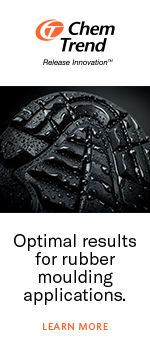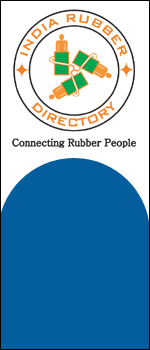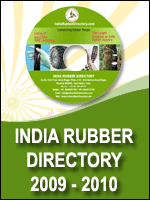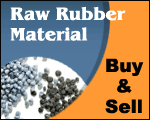Protein Allergy in NR
Latex Products
By Jose Paul. M.
Rubber Technologist, Midland Latex Products Ltd.,
Kakkand, Kochi.
INTRODUCTION
Latex has long been the material of choice for protective gloves in health care
settings, providing the wearer the flexibility, a barrier against exposure to
infectious agents, and durability. Unfortunately, for a substantial number of
healthcare workers and other regular wearers of latex gloves, latex glove
wearing also leads to a permanent allergic sensitivity to latex, which can be
life threatening. So life threatening, in fact, that once the allergic
sensitivity to latex, has fully developed its most intense form through repeated
exposure to latex, the victim may no longer be able to tolerate latex products,
without risking his or her very life. As a result, many productive careers,
primarily of doctors, dentists and nurses in the USA and Europe have been
brought to a grinding halt due to allergic sensitivity to Latex.
The root cause of this problem is attributed to the residual extractable protein
present in the latex product. The problem becomes all the more serious when we
find that there are hundreds of latex products being used regularly by medical
practitioners. The produced range from gloves to dental dams to enema cuffs.
The Latex protein Toxic Syndrome is an intense, usually – progressive allergy to
one or more of the proteins which naturally occur in nature rubber latex. Like
many serious allergies, the syndrome results from a Type immunoglobulin E (lgE)
reaction to the protein allergens in the latex. Type I reaction involving
immediate hypersensitivity to latex were first reported in Germany in 1927. in
1983, researchers specifically attributed this to latex glove use allergic
sensitivity, in a cohort of healthcare. Hundreds of reports of injury due to
protein allergy have been reported to FDA from the late 80’S. About 20 deaths
have been reported so far in USA alone, due to latex allergy. The incidence of
lgE mediated latex allergy has been reported as being as high as 10% with over
5.5 million healthcare workers in the united States alone, an estimated half a
million healthcare workers may currently be sensitized to latex and thus at risk
for serious reactions of latex allergy. People at risk are those in latex-rich
environments, such as operating rooms. This make the healthcare workers a high
risk group. The other hightly latex protein exposed occupations. Include
paramedics, firemen, and police. People who had multiple surgeries or other
medical procedures are at risk of becoming latex sensitive because they have had
repeated exposure to latex products. Children with conditions requiring frequent
operations. Workers in the rubber industry, and persons with history of other
lgE dependent allergies run a high risk of latex allergy.
The main routes of exposure to the proteins in latex are:
• Direct skin contact during glove wearing, and
• Inhalation into the respiratory tract of airborne protein allergens in latex
gloves.
Healthcare workers’ exposure to the protein allergens in latex gloves is aided
by four basic facts. They are:
• The protein allergens in latex are water-soluble
• The glove powder intended to assist the wearer in donning and removing the
gloves absorbs proteins and get aerosolized. The aerosolized protein absorbed
powder get into the lungs and cause reactions. The proteins themselves become
aerosolized when the latex gloves are donned and removed and float along the air
currents for some time before setting.
• Some healthcare workers, especially nurses, tend to don and remove 30-40 pairs
o latex glove each day, creating a great deal of aerosolized latex protein.
• Many health care workers spend the greater part of their long shifts
continually wearing latex gloves.
During frequent and regular use, the protein allergens in latex gloves enter the
body through the skin, respiratory tract and muscosae. In response the human
immunological system creates latex-specific lgE antibodies. Respected exposure
to the latex allergen progressively amplifies the production of antibodies,
resulting in the bodys’ growing sensitivity to the late protein allergens. After
creation, the antibodies attach to types o cells which produce histamine and
with continued latex exposure, those cells begin to release their histamine. As
exposure continues and allergic sensitivity increases, the body creates more and
more histamine. As exposure continues and allergic sensitivity increases, the
body creates more and more histamine, which accounts for the increasing range of
severity in allergic reactions, from the sniffles to death. Prevention of this
progression of events can be achieved only prior to acute sensitization, by
removing the protein allergens from the latex during glove manufacture, avoiding
the use of powder in latex gloves or a health care facilities’ ceasing the use
of latex gloves altogether and turning to one of many alternative synthetic
glove materials. Because latex proteins easily aerosolize and are thereby
inhaled, a single sensitive user’s refraining from using latex gloves in an
environment where others are using such gloves is fruitless in preventing
continued exposure and increasing sensitivity.
COMPOSITION OF LATEX
Constituent
|
% Composition |
|
Rubber Particles
Protein
Water
Sterol Glycosides
Resins
Ash
Sugars |
30-40%
2.0-3.0%
55-65%
1.0-0.5%
1.5-3.5%
0.5-1.0%
1.0-2.0% |
• Total Proteins.
Proteins which constitute about 2.0 to 3.0% of fresh natural rubber latex
consist of a variety of component, both water soluble an water insoluble. It is
the water soluble proteins eluded from latex products that are found to cause
allergic reactions in human beings. Proteins in fresh latex are distributed in
the three fractions as: the rubber phase (27%) the B-Serum (25%) and the C-Serum
(48%). The proteins in the rubber fraction are mainly associated with the
interfacial layer surrounding the rubber particles. They are mostly water
insoluble and are only extractable by detergents. There is however a small
fraction of the rubber particle proteins (1 mg/gm rubber) which are water
soluble and extractable by ammonia. They are largely anionic proteins. The major
proportion of water soluble proteins in fresh latex is derived from the B and C
sera. They consist of a variety of both anionic and cationic proteins. A few low
molecular proteins are also observed. Hevein, a B-Serum protein could be one of
them.
TOTAL PROTEINS
|
Fresh Latex |
30-50 mg/gm |
|
HA Latex concentrate |
16-26mg/gm |
The fresh latex contains about 3.-50 mg/gm of total proteins, which reduces
to about 16-26 mg/gm of proteins in the HA latex concentrate. The rubber
particle proteins remain qualitatively similar to those of fresh latex.
Quantitively, they are expected to differ as more ammonia extractable proteins
will be dissociated from the rubber particles. The serum proteins however differ
significantly. A fewer number of proteins is present in the HA latex serum
compared to a great variety of them in fresh latex serum. This is largely due to
the loss of the proteins remaining are mainly anionic. The high molecular weight
proteins which appear prominently in the fresh latex serum are significantly
reduced in HA latex serum.
The latex serum proteins change further on compounding the Ha latex concentrate
with sulphur vulcanizing ingredients. The concentration of the high molecular
weight proteins decreases while the level of low molecular weight proteins
remains high. On heating the compounded latex at 70ºC for 2 hours the high
molecular weight proteins completely degrade leaving only the low molecular
weight proteins.
• Extractable Proteins
The amount of water extractable proteins from latex film is very much lower than
the actual amount of proteins present in the rubber.
Extractable Proteins
HA Latex film
|
0.04 mg/gm |
|
Compounded latex |
0.14 mg/gm |
|
Heated Compounded latex |
0.34 mg/gm |
The extractable protein content of a clonal HA Latex is
only about 0.04 mg/gm rubber whereas the total protein content of Ha Latex is 20
to 26 mg/gm rubber. Compounding the latex increases the amount of extractable
protein to 0.14 mg/gm rubber. Heating the compounded latex increases the level
of extractable proteins further to 0.34 mg/g, rubber. The extractability of
proteins from latex film could thus depend on the presence of soap and the ionic
species in the system. The nature of proteins could also contribute to the
extractability of the proteins from the latex film. In HA latex the composition
of extractable proteins is different from the serum proteins. More of high
molecular weight proteins are extracted. In the compounded and prevulcaanised
lattices the composition of the extractable proteins is roughly the same as the
serum proteins. The major low molecular weight serum proteins are extractable
from both films. This indicates some changes to the nature of these proteins on
compounding the HA latex, making them moiré extractable from compounded than
uncompounded latex films.
ALLERGY TO LATEX PRODUCTS
• Delayed Cutaneous hypersensitivity: Type IV Allergy
This is a contact dermatitis generally due to the chemicals used in latex glove
manufacture. It is medicated via T cells. The reaction is typically seen 6 to 48
hours after contact. The reaction is local and limited to the skin that has
contacted the glove. Those with type IV allergy are at a greater risk of
developing Type I allergy. The tom skin makes the entry of latex proteins
easier.
• Immediate Reaction: Type I Allergy
These are systematic reactions caused by circulating lgE antibodies to the
proteins in natural latex. Symptoms include hives, rhinitis, conjunctivitis,
asthma due to bronchoconstruction, and in severe cases anaphylaxis and
hypotension. Symptoms occur soon after exposure to latex. The route of
sensitization are mucosal, cutaneous, parenteral and aerosol.
Irritant Dermatitis are caused by frequent hand washing and inadequate drying.
Aggressive scrubbing technique or detergent usage, mechanical abrasive effect of
glove powder, climatic irritation and emotional stress. This causes skin tears
that can allow easier entry of the sensitizing latex proteins or glove chemicals
and in tum lead to skin allergy.
“SAFE PROTEIN LEVELS”
It is difficult to define a safe protein level. The main problem is that we do
not know exactly which proteins case type I allergy. Total proteins can give a
good indication of the likelihood of a glove causing a hypersensitivity
reaction, but need not necessarily be an indication of the allergenic proteins.
It is possible that a glove low in allergen content may be high in total protein
content and vice versa. Therefore an absolute safe level may be difficult to
define. There is a scientific consensus that reduced protein levels will lower
the potential for both sensitization of non-sensitized individuals and allergic
reactions in sensitized persons. The consensus is the residual protein content
level of 50 microgram per gram of glove be regarded as fairly safe level.
To safeguard the interests of the consumers the US FDA has introduced certain
labeling requirements. The labeling on the product should include a statement
that the product contains natural rubber latex. FDA encourages manufacturers to
label gloves with a protein claim, but it does not accept a claim below 50
microgram per gram of glove. It is also imperative for a manufacturer to state I
their labeling statement that safe use of the glove on or by latex sensitized
individuals has not been established.’
PROTEIN REDUCTION METHODS
There are many methods for reducing the residual proteins in natural rubber
latex products. Some of them are leaching, chemical treatments, chlorination and
proprietary coatings.
• Leaching
Leaching is the process of treating the products with hot water. The hot water
treatment removes the extractable proteins from the product. Leaching can be
done in the wet gel (pre) stage or in the cured (Post) stage, but a combination
of both the methods are found to be ideal. For short leaching times, post
leaching is better than pre leaching. The surface that is in contact with the
former during leaching shows much lower extractable protein content than the
leaching surface. Thicker films require longer leaching time. Even though
leaching is one of the most widely used techniques of residual protein reduction
it is found that it cannot reduce the proteins to level below 50 microgram per
gram of glove. This calls using some other techniques to reduce the protein
level to below 50 microgram per gram. One such technique is the usage of
chemicals treatments.
• Chemical treatment
Chemical treatments are generally done along with hot water leaching to reduce
the proteins content to well below the threshold value. Different types of
proprietary chemicals are being used to reduce proteins. The identity of many
chemicals are a closely guarded secret. Chemical treatment should be done
carefully as any residual chemical left on the glove can result in Type IV
allergy. So, only chemicals that are harmless to humans should be used. The
Product should also be put through dermatological tests to ensure that it
doesn’t irritate the skin.
• Chlorination
Chlorination is the process of degrading the gloves in a controlled manner. The
gloves are very low in proteins due to the process of chlorination. It is often
difficult for manufacturer to control the process and therefore results in a
product of poor quality. The gloves therefore have a bad reputation for quality
in the market. Many companies manufacturing chlorinated gloves have been
blacklisted by the FDA due to this.
• Proprietary Coatings
There are many varieties of gloves with proprietary coatings. The most popular
ones are those with polymer coating and those with a hydrogel coating.
Information of these types of gloves are limited due to their proprietary
nature. Some types of gloves are coated with antiseptics to prevent infection
due to germs.
ALTRNATIVES TO NR LATEX GLOVES
May types of gloves, made from synthetic rubber, have been developed as an
alternative to natural rubber latex gloves. Some of them are;
• Plasticised PVC
PVC (Poly Vnyl Chloride) is a cheaper alternative NR Latex gloves but has poor
elasticity and tear strength. There has also been reports of allergic reactions
to additives from the manufacturing process. It is usually used for only
examination gloves. Disposal of PVC by incineration is known to release the
monomer vinyl chloride, a known carcinogen.
• Nitrile gloves and chloroprene gloves
The tensile strength is poor compared to NR latex gloves while their elastic
modulus tends to be higher leading t fatigue during use. Incineration can lead
to release of cyanide from Nitrile gloves and HCN from Chloroprene gloves.
• Copolymer gloves
They have reduced tear strength and are found to be unsuitable for rectal or
vaginal examinations due to bursting of the seam. These gloves are rarely used
due to the above problems.
• Styrene Block copolymer gloves
The gloves may contain the monomer Styrene which is known to cause Type IV
allergic response. These gloves too are rarely used.
• Polyurethane gloves
The gloves have a high tensile strength but it’s higher modulus and elongation
at break make wearing uncomfortable. The gloves are also very expensive. Some
cases of allergic reactions to polyurethane implants have been reported
recently. This has affected the development of a polyurethane gloves as an
alternative to NR latex glove.
Nitrile gloves are considered to be the only alternative to NR Latex glove, as
it competes fairly with the latex glove with regard to the price and glove. This
is found to be the threshold level for causing latex allergic reactions.
A low protein latex glove will therefore have to have a residual protein content
of less than 50 microgram per gram of glove. To reduce the residual protein
content in the latex glove we have methods like leaching, chemical treatment,
Surface coating and Chlorination. Leaching is the most popular but it is often
difficult to reduce the protein content to below the threshold value by this
method alone. Therefore a combination of methods like leaching-Chemical
treatment-Surface coating is done to get a low protein glove. Chlorination is
another popular method of manufacturing a low protein glove. This is done by a
controlled degradation of the glove. Any loss in control, which is not a rare
phenomenon in the present manufacturing environment, can degrade the glove to
the extent to total rejection. The product therefore does not enjoy a good
reputation in the market due to this problem.
CONCLUSION
The residual proteins in latex products being the root cause of Allergic
reactions have to be reduced to the level considered ‘safe’. Many alternatives
have been tried but none could fully replace the latex glove, till now. The
quest for better alternatives is going on. Soon some product free from latex and
with similar functional properties may be developed. This is a serious threat to
the latex glove. To survive the onslaught of alternatives to latex gloves it is
imperative that we develop a low protein glove which is very low in residual
proteins.
BIBLIOGRAPHY
1. HASM.H, Proteins in natural rubber latex, latex protein Workshop.
2. GUIDANCE TO LATEX GLOVES, A Workshop manual.
3. Vesna J. Tomazic, latex proteins; Extraction and Measurement, International
latex conference.
4. FDA releases-several papers, 1989-98.
























